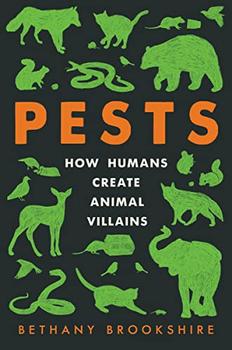Summary | Excerpt | Reviews | Beyond the Book | Readalikes | Genres & Themes | Author Bio

How Humans Create Animal Villains
by Bethany Brookshire
With our growing sense of confidence, Ritvo says, our perspective began to change. As other animal populations exploded, scientists began to realize the importance of wolves, grizzly bears, and other apex predators in the environment. People never saw wolves and forgot the fear and frustration of previous generations. Wolves became pure, admirable, and noble. Like the red squirrel, they went from pest to unjustly persecuted, helpless victims of human greed.
As the twenty-first century arrived, Americans became powerful enough to be generous. Wolves have been reintroduced to areas such as Yellowstone National Park, and are striding into places like Colorado, Idaho, and Montana.
"Most [people] have a pretty positive perception of wolves because we don't have to deal with them," Nyhus says. Ranchers, however, aren't as enthusiastic. Wolves still take out cattle and sheep. Everyone may benefit from the beauty of wolves—but it's only those who live with them who pay the price.
Right now, that cost is managed by relatively low numbers of wolves—and a compensation program for ranchers whose livestock go missing. But to some, any wolves are too many. When the U.S. Fish and Wildlife Service removed wolves from the list of Endangered and Threatened Wildlife on January 4, 2021, hunters jumped at the chance. By the end of February, a state-planned wolf hunt in Wisconsin to kill 119 animals blew past the target, killing 218 wolves in a mere sixty hours, over the strenuous objections of the local Anishinaabe peoples, whose ancestral lands are located around the Great Lakes and who include the Ojibwe, Potawatomi, Algonquin, and other tribes. Probable and confirmed wolf depredations in Wisconsin in 2020 totaled 147 animals.
Wolves are now the subject of positive press, tattoos, and really unfortunate T-shirt designs. They are symbols of the natural world. But only to some, and only as long as they don't get too numerous. They exist on our sufferance. Wolves are beautiful as long as they have no power to kill our livestock. As long as they know their place.
AS WESTERN SOCIETIES wall themselves off from the natural world, its denizens fall into two camps: the ones we rarely see and the ones we see too much. The rare animals get appreciation. They are beautiful, natural, and usually far away. The common ones, on the other hand, are so common that in the best case our eyes pass right over them. In the worst case, they intrude on our consciousness and our lives. They become pests.
The animals that we live with, that we can't control, earn increasing amounts of our wrath and disgust. They are now often associated with poverty and poor infrastructure. People view pests with the same disdain they have for unkempt yards and dirty homes.
But they are also, in a way, signs of animal success. "Humans are very good at taking up space, we're a very successful species overall," says Dawn Biehler, who studies the intersection of animals and social justice at the University of Maryland, Baltimore County. "These animals piggyback on our successes to thrive in a lot of different kinds of spaces, and part of what they're especially good at piggybacking on is social inequalities."
Biehler is the author of Pests in the City: Flies, Bedbugs, Cockroaches, and Rats, which delves into the connection between urban wildlife and human inequality. She doesn't blame a pest for being itself. "It's not their fault, the way they are. They are just fulfilling their niche requirements, the things they need to do to survive," she says.
Although our infrastructure is designed to keep nature out, every facade has its cracks. Into our carefully hidden sewers, our golden corn mazes, and our dusty attics, crept the pests. We had become successful at keeping nature out. If it got in anyway—didn't that mean that we had failed?
Areas of poverty are areas where those cracks in our infrastructure become visible. Poor neighborhoods, in the United States and well beyond, are often the last served by trash collection and sewer maintenance. They have older buildings, filled with holes and occupied by people too poor to maintain them. Sometimes public housing projects are built cheaply and not maintained, or housing is controlled by rapacious landlords who have little interest in the welfare of their tenants.
Excerpted from Pests by Bethany Brookshire. Copyright © 2022 by Bethany Brookshire. Excerpted by permission of Ecco. All rights reserved. No part of this excerpt may be reproduced or reprinted without permission in writing from the publisher.
Your guide toexceptional books
BookBrowse seeks out and recommends the best in contemporary fiction and nonfiction—books that not only engage and entertain but also deepen our understanding of ourselves and the world around us.